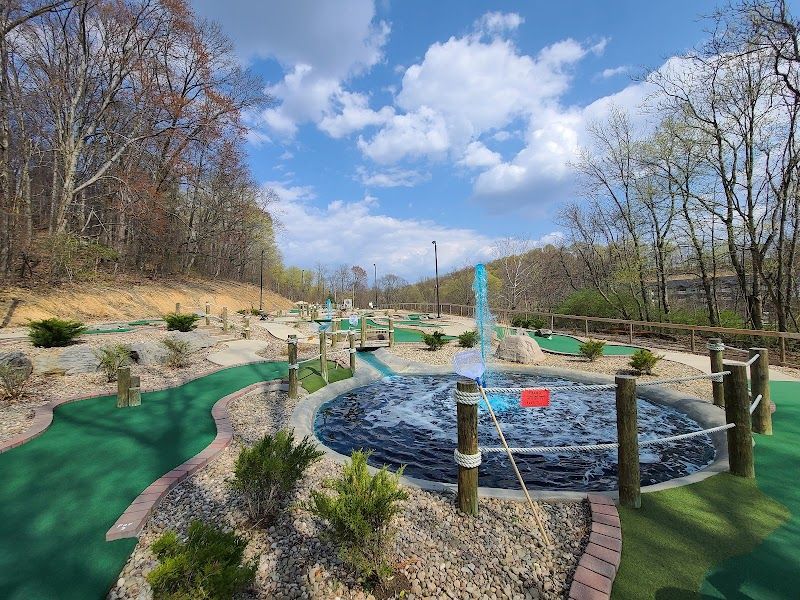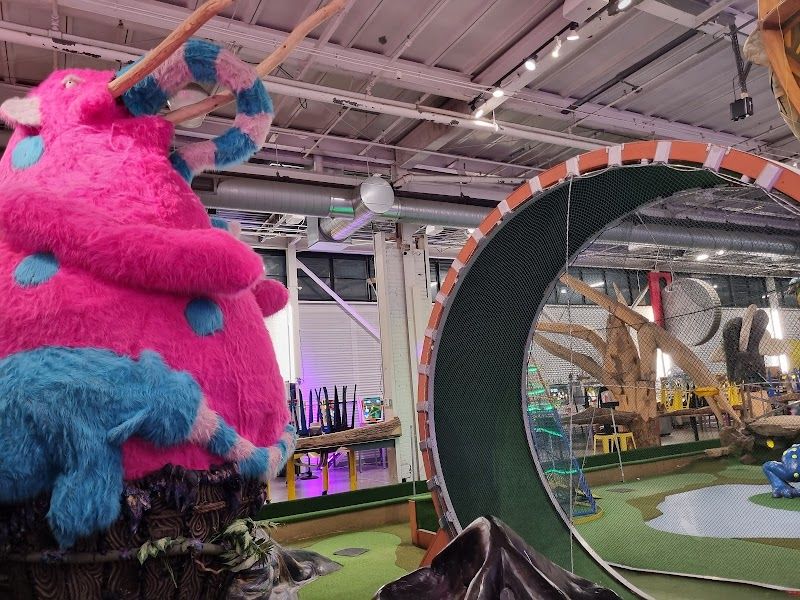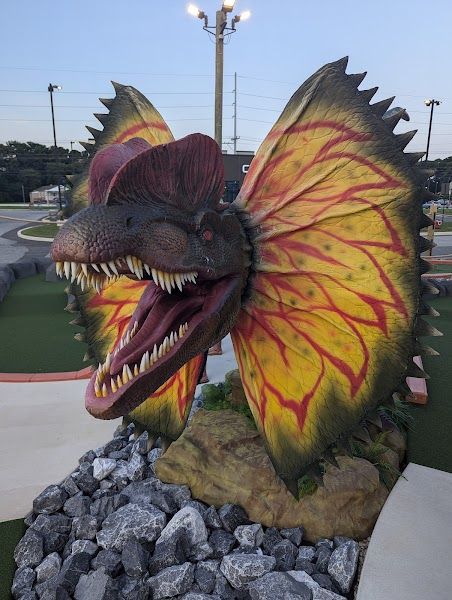Mini Golf Course Design: What Makes a Great Putt-Putt Experience

Mini Golf Course Design: What Makes a Great Putt-Putt Experience
A truly exceptional mini golf course is a carefully orchestrated blend of art, science, psychology, and entertainment. The best courses don't happen by accident—they're the result of deliberate design decisions that create memorable, challenging, and enjoyable experiences for players. Let's explore the fascinating world of mini golf course design and what separates the extraordinary from the ordinary.
Core Elements of Mini Golf Course Design
Balanced Challenge Levels
The most successful mini golf courses carefully balance difficulty across all 18 holes. A well-designed course typically includes:
Hole Variety- 25-30% easy holes (straightforward with minimal obstacles)
- 40-50% medium-difficulty holes (requiring some skill but achievable)
- 20-25% difficult holes (challenging even for experienced players)
- 1-2 signature "impossible" holes that create memorable moments
Progressive DifficultyRather than front-loading difficult holes, great courses typically:
- Start with easier holes to build player confidence
- Gradually increase complexity through the course
- Place the most challenging holes in the middle section
- End with moderately challenging but achievable holes
Recovery OpportunitiesGood design includes recovery paths that give players a chance to salvage a challenging hole rather than guaranteeing a maximum score after a single mistake.
Effective Flow and Pacing
Beyond the individual holes, course designers must consider how players move through the entire experience:
Physical Movement- Clear pathways between holes that eliminate confusion
- Natural traffic patterns that prevent bottlenecks
- Appropriate spacing between groups
- ADA-compliant accessibility considerations
Emotional Pacing- Strategic placement of particularly challenging or frustrating holes
- "Relief" holes following especially difficult ones
- Visual rewards and moments of delight throughout
- Build-up to signature holes or course features
Time ManagementWell-designed courses typically aim for:
- 90-120 minutes total play time for 18 holes
- Similar completion times for each hole (30-90 seconds)
- Minimal waiting between groups
- Natural gathering spots where brief backups won't impact enjoyment
Visual and Thematic Coherence
Whether elaborately themed or elegantly simple, great courses maintain visual coherence:
Thematic Integrity- Consistent application of theme throughout course elements
- Attention to detail in theming, even in functional elements
- Thematic progression that tells a story across the 18 holes
- Integration of theme into obstacles and challenges
Visual Communication- Clear visual cues about intended ball paths
- Obvious distinction between playing surfaces and boundaries
- Strategic use of color to indicate hazards or targets
- Lighting that highlights important course elements
Aesthetic Appeal- Photogenic viewpoints and photo opportunities
- Strategic landscaping that frames each hole
- Attention to sightlines from player perspective
- Visual rewards for accomplishing difficult shots
Famous Course Designers and Their Philosophy
The mini golf industry has produced several influential designers whose philosophies have shaped the courses we enjoy today.
Don Clayton - Putt-Putt Golf Founder
Clayton revolutionized mini golf in the 1950s with his philosophy of skill-based play over gimmicks. His design principles included:
- Geometric precision in hole layout
- Emphasis on putting skill over luck
- Clean, simple designs without moving obstacles
- Mathematical approach to creating challenging angles
- Perfect, consistent surfaces for true ball roll
Lomma Enterprises - Art Lomma
As one of the first major mini golf design firms, Lomma established many conventions that became industry standards:
- Integrated water features as both hazards and visual elements
- Standardized dimensions for obstacles like windmills
- Balanced challenge levels across 18-hole courses
- Functional beauty in obstacle design
- Durable construction techniques for outdoor longevity
Harris Miniature Golf Courses - Rick Hunsinger
This leading modern design firm approaches mini golf as an immersive experience:
- Storytelling through hole progression
- Integration of elaborate theming and landscaping
- Strategic elevation changes for visual drama
- Design psychology that creates memorable moments
- Focus on family-friendly challenges
Adventure Golf Services - Scott Lundmark
Specializing in highly themed "adventure golf" experiences, Lundmark's philosophy centers on:
- Immersive themed environments rather than individual obstacles
- Integration of sound effects and lighting
- Gamification elements beyond simple stroke counting
- Creating Instagram-worthy visual moments
- Balancing spectacle with genuine putting challenges
Obstacle Types and Their Challenges
The obstacles that define mini golf courses can be categorized based on the challenges they present to players:
Precision Challenges
These obstacles test a player's ability to hit the ball with the exact right speed and direction:
- Narrow Bridges: Requiring precise aim to avoid water hazards
- Jump Ramps: Testing exact speed control to clear gaps
- Tunnels: Demanding accurate alignment and speed
- Target Zones: Requiring pinpoint accuracy to hit specific areas
Timing Challenges
These moving obstacles introduce a time element to putting:
- Classic Windmills: Requiring players to time shots between rotating blades
- Swinging Pendulums: Creating moving barriers that must be avoided
- Synchronized Gates: Opening and closing to allow passage
- Water Features: With timed spray patterns or moving currents
Spatial Reasoning Challenges
These obstacles require players to visualize and plan complex ball paths:
- Banking Walls: Requiring use of rebound angles
- Loop-de-Loops: Testing understanding of momentum and speed
- Multiple Levels: Requiring strategic planning to navigate elevation changes
- Optical Illusions: Creating visual confusion about slopes and distances
Knowledge-Based Challenges
These obstacles reward course knowledge and experience:
- Hidden Shortcuts: Offering advantages to observant players
- Secret Passages: Alternative routes that may save strokes
- Variable Hazards: Obstacles that behave differently than they appear
- Memory Elements: Holes that reward those who remember specific patterns
How Theming Enhances the Experience
Theming isn't just decorative—it fundamentally changes how players experience a mini golf course:
Narrative Immersion
Strong theming creates a sense of place and story:
- Transports players to different times or places
- Creates a shared adventure narrative
- Distracts from frustrations of difficult holes
- Provides conversation topics during play
Enhanced Memorability
Themed elements make courses more memorable:
- Creates distinctive "signature holes" players remember
- Provides visual anchors for recalling the experience
- Offers unique photo opportunities
- Distinguishes the course from generic competitors
Disguised Difficulty
Effective theming can make challenging design elements feel more approachable:
- Complex obstacles become story elements
- Difficult shots become "quests" or "challenges"
- Technical design requirements become thematic necessities
- Failure becomes part of the narrative rather than purely frustrating
Extended Engagement
Thematic elements can increase engagement beyond just the putting:
- Encourages exploration of the course environment
- Creates secondary activities (finding hidden elements)
- Provides entertainment during waiting periods
- Appeals to non-players in family or group settings
Physics and Geometry in Course Design
Behind the whimsical facades, mini golf course design relies on precise physics and geometry:
Slope Calculations
Course designers carefully calculate:
- Maximum and minimum slopes for fair play (typically 3-7 degrees)
- Compound slopes that create challenging but predictable ball paths
- Banking angles on curved surfaces for desired ball behavior
- Transitions between different slopes to maintain ball control
Material Science
Different materials affect ball behavior in ways designers must account for:
- Felt/Carpet Surfaces: Offering consistent speed but affected by direction of pile
- Artificial Turf: Providing natural feel with controllable speed ratings
- Concrete/Hardscape: Creating faster play requiring more precise speed control
- Rubber Elements: Affecting bounce predictability at obstacles
Optimal Challenge Design
The mathematics of creating the perfect challenge includes:
- Calculating success probabilities for various shot approaches
- Designing obstacles with appropriate "failure rates"
- Creating risk/reward scenarios with mathematical underpinnings
- Ensuring statistical distribution of likely scores across holes
Environmental Adaptations
Outdoor courses must account for:
- Temperature effects on material expansion and contraction
- Drainage calculations for water management
- Wind effects on ball behavior in open areas
- Sun angle changes throughout day affecting visibility
America's Best-Designed Courses to Experience Firsthand
To truly appreciate the art and science of mini golf design, visit these exceptionally well-designed courses:
Mighty Jungle Golf - Myrtle Beach, South Carolina
Design Excellence: This course exemplifies perfect balance between theming and gameplay, with a jungle adventure narrative that enhances rather than overshadows the putting challenges. Notable Features:- Progressive difficulty curve that builds player confidence
- Masterful use of elevation changes creating dramatic sightlines
- Water features integrated as both hazards and visual elements
- Exceptional flow between holes preventing bottlenecks
Par-King Skill Golf - Lincolnshire, Illinois
Design Excellence: Famous for its innovative mechanical obstacles, this course represents the pinnacle of custom-designed moving elements that create unique challenges. Notable Features:- One-of-a-kind mechanical obstacles including the famous roller coaster
- Perfect timing challenges requiring skill rather than luck
- Precise engineering ensuring consistent obstacle behavior
- Balance of spectacular signature holes with skill-based standards
Disney's Winter Summerland - Orlando, Florida
Design Excellence: This Disney-designed dual course showcases perfect thematic integration while maintaining excellent playability. Notable Features:- Dual-themed courses (summer and winter) with consistent design principles
- Masterful storytelling through progressive hole design
- Perfect sightline management creating visual surprises
- Exceptional accessibility considerations without compromising challenge
Around the World Mini Golf - Lake George, New York
Design Excellence: This course demonstrates how educational theming can enhance rather than distract from excellent gameplay design. Notable Features:- Geographically progressive theming with each hole representing a different country
- Strategic use of terrain to create natural challenges
- Perfect balance of visual spectacle and putting challenge
- Exceptional flow management for high-volume play
Urban Putt - San Francisco, California
Design Excellence: This indoor course showcases how artistic vision and technical design can combine to create unique putting challenges. Notable Features:- Artist-designed holes that function as interactive sculptures
- Perfect integration of mechanical and digital elements
- Sophisticated use of limited space creating immersive environments
- Technical innovation in obstacle design and function
The Future of Mini Golf Design
Mini golf course design continues to evolve with new technology and changing player expectations:
Interactive Technology Integration
- RFID-embedded balls that trigger course elements
- Projection mapping creating dynamic surface changes
- App integration for enhanced scoring and gamification
- Augmented reality overlays adding digital elements to physical courses
Sustainable Design Practices
- Water reclamation systems for water features
- Solar-powered lighting and moving elements
- Sustainable materials replacing traditional construction
- Naturalistic designs working with local environments
Competitive-Focused Design
- Tournament-ready courses with standardized challenges
- Broadcast-friendly layouts for competitive events
- Training-specific holes for skills development
- Adaptable difficulty levels for different player capabilities
Multi-Sensory Experiences
- Integrated sound design enhancing themed elements
- Scent design creating immersive environments
- Tactile elements beyond simple putting surfaces
- Temperature variations enhancing themed areas
Experiencing Great Course Design Yourself
Want to appreciate the art and science of mini golf design firsthand? Use our mini golf directory to find exceptional courses near you. Look for:
- Courses that have won design awards
- Venues created by recognized design firms
- Recently renovated facilities with modern design principles
- Highly-rated courses with reviews mentioning flow and challenge balance
Whether you're a casual player or mini golf enthusiast, understanding the thoughtful design behind great courses can enhance your appreciation of this beloved activity. The next time you're navigating a particularly clever hole or admiring a themed element, remember the careful planning and design expertise that created that perfect putt-putt moment.

